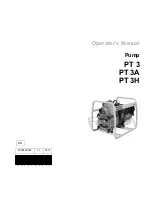
1.3.3 Refrigerant
If applicable. Consult the installation manual of your
application for more information.
WARNING
During tests, NEVER pressurize the unit with a
pressure higher than the allowed maximum
(as indicated on the nameplate of the unit).
WARNING
Take sufficient precautions in case of refrigerant
leakage. If refrigerant gas leaks, ventilate
the area immediately. Possible risks:
Excessive refrigerant concentrations in a
closed room can lead to oxygen deficiency.
Toxic gas may be produced when
refrigerant gas comes into contact with fire.
DANGER:
RISK
OF
EXPLOSION
Pump-down
–
Refrigerant leakage
. If you want
to pump-down the system, and there is a
leakage in the refrigerant circuit:
Do NOT use the unit's automatic pump-
down function, with which you can collect all
refrigerant from the system in the outdoor
unit.
Possible consequence
: Self-
combustion and explosion of the
compressor because of air entering the
operating compressor.
Use a separate recovery system to ensure
that the unit's compressor does NOT need
to operate.
WARNING
Always recover the refrigerant. Do NOT throw it
out directly into the environment. Use a
vacuum pump to evacuate the installation.
NOTICE
To avoid compressor breakdown, do NOT
charge more than the specified amount of
refrigerant.
When the refrigerant system needs to be
opened, refrigerant must be treated
according to the applicable legislation.
WARNING
Make sure there is no oxygen in the system.
Refrigerant may only be charged after
performing the leak test and the vacuum
drying
.
In case re-charge is required, consult the
nameplate of the unit. It mentions the type of
refrigerant and required amount.
The unit is factory charged with refrigerant.
Only use tools allowed for the refrigerant type used
in the system, this to ensure pressure resistance
and prevent foreign materials from entering into
the system.
Charge the liquid refrigerant as follows:
If
Then
A siphon tube is present
(i.e. the cylinder is
marked with "Liquid
filling siphon attached")
Charge with the cylinder
upright.
A siphon tube is NOT
present
Charge with the cylinder
upside down.
Open refrigerant cylinders slowly.
Charge the refrigerant in liquid form. Adding it in
gas form may prevent the unit from normal
operation.
CAUTION
When the refrigerant charging procedure is done
or when pausing, close the valve of the
refrigerant tank immediately. If the valve is
not closed immediately, remaining pressure
might charge additional refrigerant. Possible
consequence: Incorrect refrigerant amount
.
1.3.4 Water
If applicable. Consult the installation manual of your
application for more information.
NOTICE
Make sure water quality complies with EU
directive 98/83 EC
.
Содержание EKHH2E200AAV3
Страница 3: ...Version Log Version code Description Date 4P509215 1 Document release 20 12 2017...
Страница 4: ...Page 4 20 12 2017 Version 1 0...
Страница 36: ...Page 36 20 12 2017 Version 1 0 Parameter description Code U M Min Max Default Notes RESERVED E9 0 2 0...
Страница 41: ......
Страница 42: ...Page 42 20 12 2017 Version 1 0 Nov 17...








































